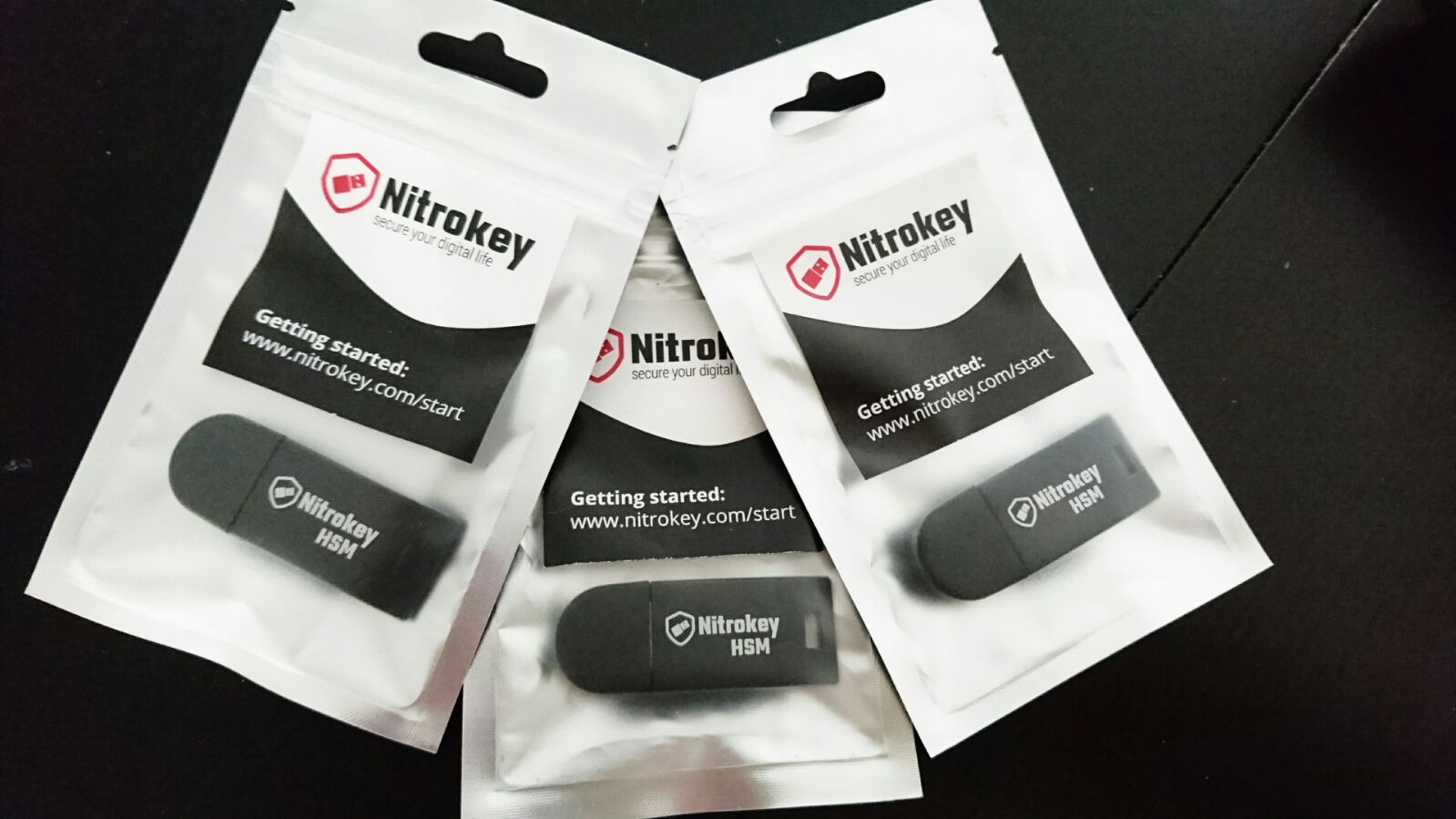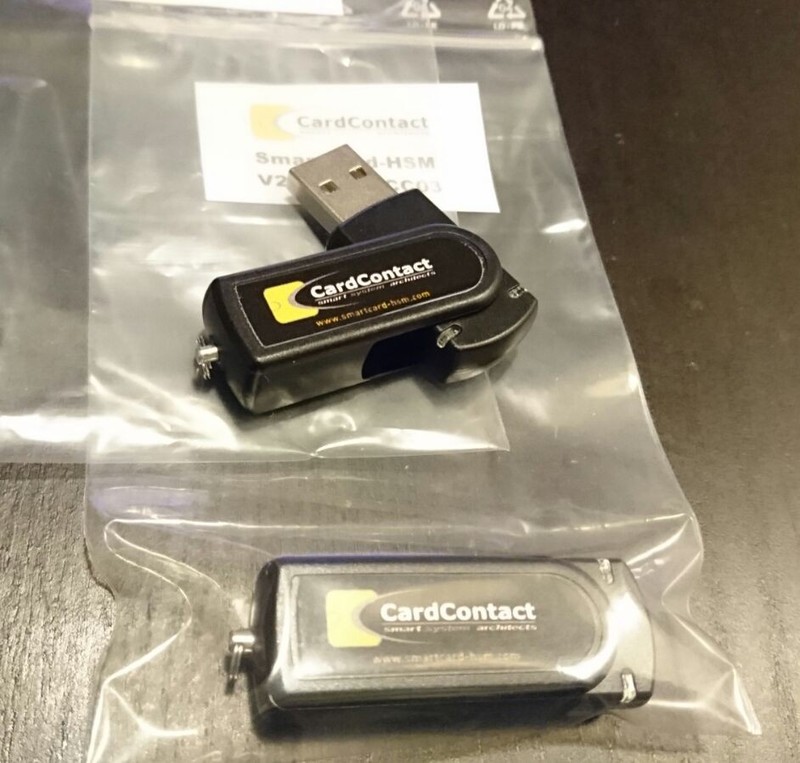Raymii.org

Quis custodiet ipsos custodes?Home | About | All pages | Cluster Status | RSS Feed
Storing arbitraty data in the Nitrokey HSM/SmartCard-HSM with Elementary Files (EF)
Published: 17-07-2016 | Author: Remy van Elst | Text only version of this article
❗ This post is over eight years old. It may no longer be up to date. Opinions may have changed.
Table of Contents

Three Nitrokey's in their bags
This is a guide which shows you how to write small elementary files to a nitrokey HSM. This can be usefull if you want to securely store data protected by a user pin. You can enter the wrong pin only three times, so offline brute forcing is out of the picture.
Introduction
The Nitrokey HSM is an open hardware and open software device. It is a USB version of the SmartCard-HSM. Both the SmartCard-HSM as the Nitrokey HSM have sources available and are fully supported by the OpenSC project.
I have multiple articles on the Nitrokey HSM/SmartCard-HSM. I also have a lot of professional experience with large expensive HSM hardware.
If you want to know more on the Nitrokey HSM then please read the getting started articles.
Recently I removed all Google Ads from this site due to their invasive tracking, as well as Google Analytics. Please, if you found this content useful, consider a small donation using any of the options below. It means the world to me if you show your appreciation and you'll help pay the server costs:
GitHub Sponsorship
PCBWay referral link (You get $5, I get $20 after you've placed an order)
Digital Ocea referral link ($200 credit for 60 days. Spend $25 after your credit expires and I'll get $25!)

The SmartCard-HSM
You could for example, store a file in the HSM and send it via the old-fashioned mail to someone, without sending the required pin. You send that via a different channel, preferably privately in person. The other person then can read the file of the HSM using the PIN. Since you only have 3 tries for the correct PIN, you know that an offline brute force attack is not likely to happen. If you encrypted a file an placed it on a regular USB drive, the post could be intercepted and stored for offline cracking by a government agency, without you knowing it. Because the pin entries are recorded, you know immidiately when the device has been tampered with.
THe documentation states that for different PIN lengths there are different retry counters:
- The SmartCard-HSM enforces a retry counter <= 3 for PIN length 6
- The SmartCard-HSM enforces a retry counter <= 5 for PIN length 7
- The SmartCard-HSM enforces a retry counter <= 10 for PIN length larger than 7
The Nitrokey HSM/SmartCard-HSM implements a smartcard over USB. They allow, next to certificates, private keys and public keys, also arbitrary data to be stored in so called elementary files (EF).
Do note that the filesize is limited and this is not meant to store your photo collection. At the end of the page the exact filesize limit is specified for the Nitrokey HSM/SmartCard-HSM.
I will be using a test file, 16 bytes long, containing the line Remy is
awesome.
Writing files to the HSM
Using the pkcs11-tool we can write data to the HSM:
pkcs11-tool --module opensc-pkcs11.so --login --pin 648219 --write-object ~/tmp/hsm/smallfile --type data --id 5 --label 'data2'
Output:
Using slot 0 with a present token (0x0)
Created Data Object:
Data object 26411536
label: 'data2'
application: 'data2'
app_id: <empty>
flags: modifiable
Make sure to specify a --label, otherwise you cannot access it later on. (You
can, the label will be empty ('') but just set a label.)
Set the --private flag when writing to make sure you need to login first
before getting access to the stored data:
pkcs11-tool --module opensc-pkcs11.so --login --pin 648219 --write-object ~/tmp/hsm/smallfile --type data --id 5 --label 'data2' --private
Otherwise the data will be accessible to everone that has access to the device.
Viewing the data
Both the pkcs15-tool and the pkcs11-tool can be used to view the data. The
pkcs11-tool is the most convinient way:
pkcs11-tool --module opensc-pkcs11.so --login --pin 648219 --read-object --type data --label 'data2'
Output:
Using slot 0 with a present token (0x0)
Remy is awesome
Using pkcs15-tool gives you the HEX output:
pkcs15-tool --dump
Data object 'data'
applicationName: data
Path: e82b0601040181c31f0201::cf00
Data (16 bytes): 52656D7920697320617765736F6D650A
PKCS#15 HEX to ASCII
pkcs15-tool can specifically read the data object but it dumps the data in
HEX:
pkcs15-tool --read-data-object data
Output
Using reader with a card: Nitrokey Nitrokey HSM (010000000000000000000000) 00 00
Data Object (16 bytes): < 52 65 6D 79 20 69 73 20 61 77 65 73 6F 6D 65 0A >
If you've set the private flag you will need to enter the pin:
$ pkcs15-tool --read-data-object data2
Using reader with a card: Nitrokey Nitrokey HSM (010000000000000000000000) 00 00
Please enter PIN [UserPIN]:
Data Object (16 bytes): < 52 65 6D 79 20 69 73 20 61 77 65 73 6F 6D 65 0A >
This data can be converted to ascii with the xxd command:
$ echo '52 65 6D 79 20 69 73 20 61 77 65 73 6F 6D 65 0A' | xxd -r
emy is awesome
But there is data missing here. As the manual states, (SmartCard-HSM, AGD User
Manual for Version V2.3 section 5.2.2 Read binary):
There is a known incompatibility with the READ BINARY variant defined in [ISO7816-4]:The SmartCard-HSM returns the raw data contained in the EF and does not prefix a tag 53 and the length.
By prefixing the data returned with 00 we get the full string back:
$ echo '00 52 65 6D 79 20 69 73 20 61 77 65 73 6F 6D 65 0A' | xxd -r
Remy is awesome
Here is a one liner that uses awk to print text between < and > with a
00 prefix, piped to xxd:
pkcs15-tool --read-data-object data 2>&1 | awk -F'[<|>]' '/Data Object/ {print "00"$2}' | xxd -r
The one liner doesn't work if you've got --private data, since you can't enter
the PIN.
Output to a file
The data can be placed in a file as well by using the --output-file flag:
pkcs11-tool --module opensc-pkcs11.so --login --pin 648219 --read-object --type data --label data --output-file test
$ cat test
Remy is awesome
Deleting data
You create space on the HSM or just to remove data you don't need anymore, use
the --delete-object flag with the correct label:
pkcs11-tool --module opensc-pkcs11.so --login --pin 648219 --delete-object --type data --application-label data
Make sure you delete the correct data, otherwise you might just have removed your keypair.
Maximum file size
The files I wrote are all small files. Tests show that the maximum filesize for
these elementary files (EF) is 5000 bytes.
Specifically tested by writing a file larger than 5000 bytes (test) to the HSM
and reading it back to an output file (test2):
$ du -b test*
5008 test
5000 test2
That means that in this case you must make sure to write less than 5 KB to the HSM. Plenty of space for some sensitive text files.
Tags: articles , cryptoki , dkek , elementary-files , hsm , nitrokey , openssl , pkcs11 , safenet , sc-hsm , smartcard , smartcard-hsm